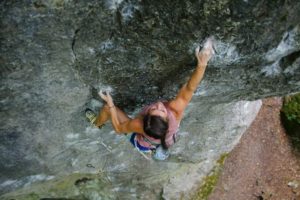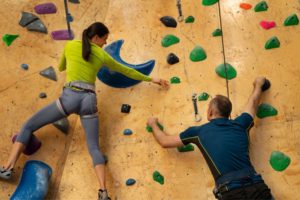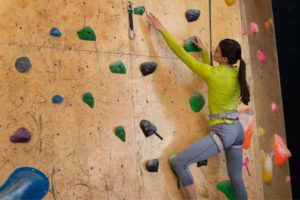If you’re looking for a comprehensive guide to 3 finger drag climbing, you’re at the right place.
This guide will give you all the information and insights you need to improve your three-finger drag technique.

Whether you’re new at climbing and looking to boost your climbing skills or a seasoned climber who wants to learn new moves, we’ve got you covered.
So, let’s discover the advantages, techniques, and tips to elevate your climbing game to new heights!
What is a 3 Finger Drag Climbing?
3-finger drag climbing is a technique used in rock climbing where you grip the surface using only three fingers: the middle finger, ring finger, and pinky.
The index finger is tucked away during this technique. It gives climbers an advantage in certain situations.
By using this technique, climbers can have better stability, accuracy, and control. It comes in handy when facing tough climbing routes.
Mastering this technique can boost your climbing skills and give you the confidence to conquer new heights.
How Do You Train 3 Finger Drag for Climbing: 5 Methods
Here’s a list of methods that can help you train this technique:
1. Strengthen Your Fingers
You can do exercises like finger curls, hangboarding, or grip trainers designed for your fingers.
These exercises will make your fingers stronger, helping you hold onto climbing holds better.
Pros: These exercises help strengthen your fingers, making them more capable of gripping and holding onto climbing holds.
Cons: It can take time and consistent practice to see noticeable improvements in finger strength.
2. Focus on a Three-Finger Grip
Include exercises in your training that specifically target improving your grip using three fingers.
This will help you get better at using the three-finger drag technique in climbing.
Practice holding onto small edges or pockets using only the middle finger, ring finger, and pinky, gradually increasing the difficulty and duration as you progress.
Pros: By focusing on the three-finger grip, you can specifically train the muscles and tendons required for the three-finger drag technique.
Cons: It can be challenging initially, and progress can be slower compared to training with all four fingers.
3. Bouldering and Route Practice
Incorporate bouldering and route climbing sessions that feature holds suitable for the 3-finger drag technique.
Seek out climbs that require this technique and practice them repeatedly to improve your proficiency and adaptability.
Pros: Practicing on boulders and climbing routes that feature holds suitable for this technique allows you to apply the technique in a realistic climbing context.
Cons: Finding suitable climbs with the specific holds needed for the technique can require some exploration or access to climbing facilities.
4. Technique Workshops and Coaching

Consider attending technique workshops or seeking guidance from experienced climbers or coaches who can provide insights, corrections, and specific training drills to refine your three-finger drag technique.
Pros: Attending workshops or receiving guidance from experienced climbers or coaches provides valuable insights, corrections, and tailored training drills to improve your technique.
Cons: Availability of workshops or access to experienced climbers/coaches can vary depending on your location.
5. Gradual Progression
Take a gradual approach to training, allowing your fingers and tendons to adapt and strengthen over time.
Avoid pushing yourself too hard or overdoing it when training the three-finger drag technique to prevent injuries.
Listen to your body, and give yourself enough rest and recovery time.
Pros: Taking a gradual approach minimizes the risk of injury and allows your fingers and tendons to adapt and strengthen gradually over time.
Cons: Progress can seem slow at times, requiring patience and consistency.
What Happens When We Train Our Grip?
When we train our grip, several beneficial things happen, such as the following:
Stronger Hands
Working on our grip strengthens the muscles and tendons in our hands and forearms.
And you know what that means? It helps us grab hold of things, like climbing holds, way better than before!
Better Stability
One of the best things about having a strong grip is the added stability and control it gives us.
When we can hold onto objects with a firm grip, we reduce the chances of slipping or losing our hold. Just imagine how helpful that is when we’re climbing or lifting weights!
Improved Stamina
Grip training can improve our stamina too. That means we can hold onto things longer without feeling tired or uncomfortable.
This is especially handy for activities like rock climbing or challenging obstacle courses that demand a strong grip for extended periods.
More Flexible Fingers
When we engage in grip training, we do precise finger movements that make our fingers more flexible and coordinated.
So it’s not just about having a killer grip; it also has positive effects on tasks that require delicate finger movements.
Think about playing musical instruments or tackling those intricate manual tasks that need nimble fingers.
Injury Prevention
Strengthening our grip can help prevent injuries, such as strains or sprains, by improving the stability and support provided to our hands and wrists.
This is especially important in activities that place repetitive stress on the hands and forearms.
How to Prevent 3 Finger Drag Injury?
Here’s a list of helpful tips to help you avoid injuries:
Warm-Up
Properly warming up your body before climbing is very important. Take the time to warm up your whole body and pay special attention to your fingers, wrists, and forearms.
Engage in gentle stretching exercises, gradually increasing the intensity to ensure your muscles and tendons are ready to tackle climbing challenges.
Take Your Time

Climbing is a journey, and it’s important to progress at a pace that suits your current abilities. Avoid rushing into climbs or maneuvers that are way beyond your skill level.
Instead, give yourself the necessary time to gradually build up your strength, technique, and finger strength.
By taking small steps forward, your body can adapt better, which significantly lowers the risk of injuries along the way.
Remember, it’s all about being patient and steadily improving!
Proper Technique
Use proper climbing techniques to reduce stress on your fingers and tendons.
This includes using your legs for support and balance, maintaining good body positioning, and utilizing efficient hand placements.
Improving your technique can help distribute the load evenly across your entire hand and minimize the strain on specific fingers.
What Does Your Body Say?
Be mindful of warning signs or discomfort in your fingers or wrists. If you feel any pain, soreness, or unusual sensations, it’s important to listen to your body.
Take the necessary rest and recovery periods to allow yourself to heal. Pushing through pain can cause more harm and setbacks.
Rest and Recovery
Allow your body sufficient time to rest and recover between climbing sessions.
Adequate rest helps your muscles and tendons repair and strengthen, reducing the risk of overuse injuries.
Incorporate rest days into your training schedule and prioritize sleep and proper nutrition to support your body’s recovery process.
Mix Up Your Training
Don’t limit yourself to climbing alone. Explore a variety of exercises and activities that target the muscles and tendons essential for climbing.
It’s not just about focusing on your fingers and wrists; your core, back, and shoulders play crucial roles too.
By incorporating exercises that strengthen these areas, you provide your fingers with extra support and stability, significantly lowering the chances of getting hurt.
Get Professional Help
If you’re new to climbing or have any concerns about your technique or injury prevention, it’s wise to contact a qualified climbing coach or instructor.
They can offer valuable guidance, teach proper training methods, and help you create a safe and effective climbing routine.
3 Finger Drag Climbing: Conclusion
We hope this guide has given you a deeper understanding of the 3-finger drag climbing technique.
By incorporating this valuable skill into your climbing repertoire, you can confidently enhance your strength, improve your grip, and tackle challenging routes.
Just practice consistently, listen to your body, and prioritize safety while climbing.

I was working as a mountain guide, probably all around the planet. One day, I met my wife in the mountains, literally on top of the world. Now, I have a beautiful family and three kids, so I don’t have much time for climbing, but sometimes I go camping with my friends. I am also into gym workouts, and I can’t imagine my life without sports.
Since I ended my professional career as a climbing guide, I’ve been giving personal classes and helping amateurs to get ready for conquering their first peaks. Also, that’s how the whole blog idea appeared.





